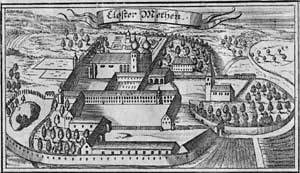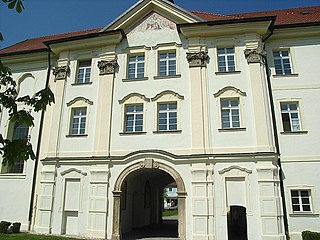
Aldersbach Abbey (German : Kloster Aldersbach) is a former Cistercian monastery in the community of Aldersbach in the district of Passau in the valley of the Vils, Lower Bavaria, Germany.

Aldersbach Abbey (German : Kloster Aldersbach) is a former Cistercian monastery in the community of Aldersbach in the district of Passau in the valley of the Vils, Lower Bavaria, Germany.
It was founded in 1127 by Saint Otto, Bishop of Bamberg, as a community of Augustinian Canons, on a site near a church consecrated in 880 by Englmar, Bishop of Passau, in honour of Saint Peter. [1] In 1146 Egilbert, the successor of Otto, gave the foundation and a new church of Our Lady to the Cistercians, and after the departure of the canons, Abbot Sefried, with monks from Ebrach Abbey, took possession.
Under Cistercian rule Aldersbach flourished for more than six centuries. It was famous for the rigour of its religious discipline and exerted a wide influence. From here were founded the religious houses of Fürstenfeld (1263), Fürstenzell (1274), and Gotteszell (1285). The monks cultivated the soil and devoted themselves to the pastoral work of their own and in the neighbouring churches dependent upon the abbey. Nor did they neglect the pursuit of learning: the first abbot, Sefried, formed the nucleus of the library to which valuable additions were made by his successors.
During the Thirty Years' War which followed the Reformation, the abbey was pillaged and almost entirely abandoned. The library however escaped destruction, and under the abbots Matthew and Gebhard Horger the old régime was restored. Abbot Theobald II repaired the injuries sustained during the wars of the Spanish and Austrian Successions.
The abbey was suppressed on 1 April 1803 during the secularisation of Bavaria; the monks then numbered forty. The buildings were sold, and the abbey church was converted into a parish church, while the monks engaged in parish work or teaching. The library became a part of the Bayerische Staatsbibliothek at Munich.
Aldersbach was fortunate in its abbots. They maintained monastic discipline, furthered the interests of the abbey, and encouraged the pursuit of learning. Among the more prominent, besides those already mentioned, were Dietrich I (1239–53, 1258–77); Conrad (1308–36); John II, John III, and Wolfgang Marius, who is perhaps the best known. He had studied at Heidelberg, and was the author of several works. Father Stephan Wiest also became known later as a theologian. He taught at the University of Ingolstadt, of which he was rector from 1787 to 1788, and six years later returned to Aldersbach, where he died in 1797.
Brewing was first recorded in the monastery in 1268. [2] The abbey brewery passed in 1811 into the hands of Johann Adam von Aretin, whose family still own it (as at 2007) as the Brauerei Aldersbach.
Adam of Ebrach was a Cistercian monk and the first abbot of Ebrach Abbey in the area of Bamberg, Bavaria, Germany, and later the founding abbot of Langheim Abbey.

Metten Abbey, or St. Michael's Abbey at Metten is a house of the Benedictine Order in Metten near Deggendorf, situated between the fringes of the Bavarian Forest and the valley of the Danube, in Bavaria in Germany.

Aldersbach is a municipality in the district of Passau in Bavaria in Germany. The former Cistercian Aldersbach Abbey, of which the Baroque church remains, is located in the village. There is also a brewery with museum. Aldersbach has around 4,500 inhabitants.

Dobrilugk Abbey was a Cistercian monastery in Lower Lusatia in the territory of the present town of Doberlug-Kirchhain, Brandenburg, Germany.

Fürstenfeld Abbey is a former Cistercian monastery in Fürstenfeldbruck, Bavaria, Germany.

Schöntal Abbey is a former Cistercian abbey in Schöntal in the district of Hohenlohe, Baden-Württemberg, Germany. It is famous as one of the most impressive pieces of Baroque architecture in northern Württemberg and is now used by the Diocese of Rottenburg-Stuttgart as a retreat and training centre.

Engelszell Abbey was the last Trappist monastery in Austria. It is located near Engelhartszell an der Donau in the Innviertel in Upper Austria.

Amelungsborn Abbey, also Amelunxborn Abbey, is a Lutheran monastery in Lower Saxony, Germany. It is located near Negenborn and Stadtoldendorf, in the Landkreis of Holzminden in the Weserbergland. It was the second oldest Cistercian foundation in Lower Saxony, Germany, after Walkenried Abbey. It survived the Reformation by becoming Lutheran, and with Loccum Abbey, also previously Cistercian, is one of the only two Lutheran monasteries in Germany with an uninterrupted tradition. The abbey church, St. Mary's, is also the parish church of the abbey's former estate villages Negenborn and Holenberg.

Altzella Abbey, also Altzelle Abbey, is a former Cistercian monastery near Nossen in Saxony, Germany. The former abbey contains the tombs of the Wettin margraves of Meissen from 1190 to 1381.

Arnsburg Abbey is a former Cistercian monastery near Lich in the Wetterau, Hesse, Germany. It was founded by monks from Eberbach Abbey in 1174. Although heavily damaged in the Thirty Years' War it was rebuilt later in the 17th century and prospered in the 18th century, when much of the abbey was rebuilt in Baroque style.

Neustadt am Main Abbey was an abbey of the Benedictine Order in Neustadt am Main, Bavaria, Germany. It existed from the 8th century until the dissolution of abbeys in the course of secularization in 1803. During its heyday in the early Middle Ages, the abbey was a political power that vied for regional influence with the Prince-bishops of Würzburg, the Archbishops of Mainz and the Counts of Rieneck. Today its location is occupied by a monastery operated by the nuns of the "Dominican Order of Saint Catherine of Siena", also known as Kloster Neustadt. The former abbey church today serves as the Catholic parish church for Neustadt.

Buch Abbey, in German Kloster Buch, is a former Cistercian monastery near Leisnig in Saxony.

Tennenbach Abbey was a Cistercian abbey in what is now the district of Freiamt in the town of Emmendingen, Baden-Württemberg, Germany. It was originally named Porta Coeli.

The Pforta monastery is a former Cistercian monastery located near Naumburg in Saxony-Anhalt, Germany. It was established in the 1130s and prospered in the Middle Ages. In the course of the Reformation the monastery was disbanded in 1540. Today the buildings are used by the school Landesschule Pforta. The site is located on the tourist route Romanesque Road and has been nominated by Germany for inclusion in the UNESCO list of World Heritage Sites.
Louis Julius Lekai, O.Cist. was an American monk, historian and university professor born in Hungary.

Anton Franz Wolfradt, O.Cist., O.S.B. was a Cistercian and Benedictine, Abbot of Wilhering then Kremsmünster, Prince-Bishop of Vienna, and President of the Hofkammer.

The Aldersbach brewery is a traditional medium-sized brewery in Aldersbach, Lower Bavaria, opened in the 13th century. It produces beer types such as Dunkel, Helles, and Pilsner, plus seasonal Bock and Pale lagers. In 2016, it won awards from the Bavarian Brewers Association and the Bavarian State Beer Exhibition.

Güterstein Charterhouse was a Carthusian monastery in the Swabian Alb near Bad Urach, Baden-Württemberg, Germany.

Fürstenzell Abbey is a former Cistercian abbey in Fürstenzell, in Bavaria, in the diocese of Passau. It was a daughter monastery of the Aldersbach monastery from the filiation of the Morimond primary abbey - Ebrach monastery.